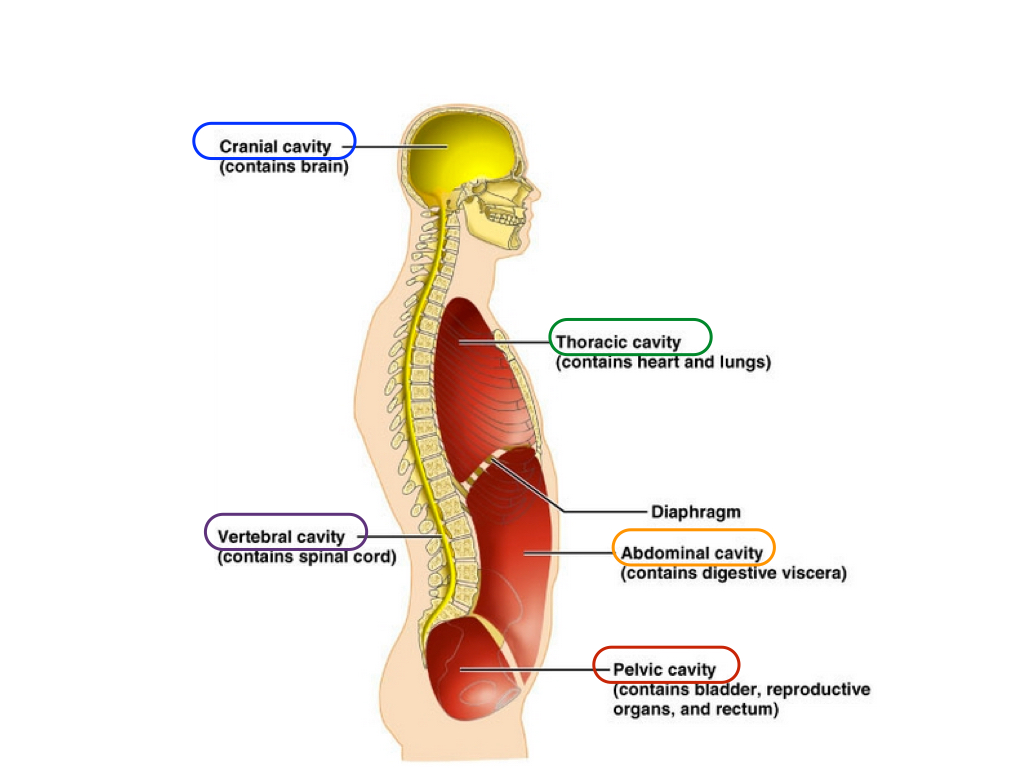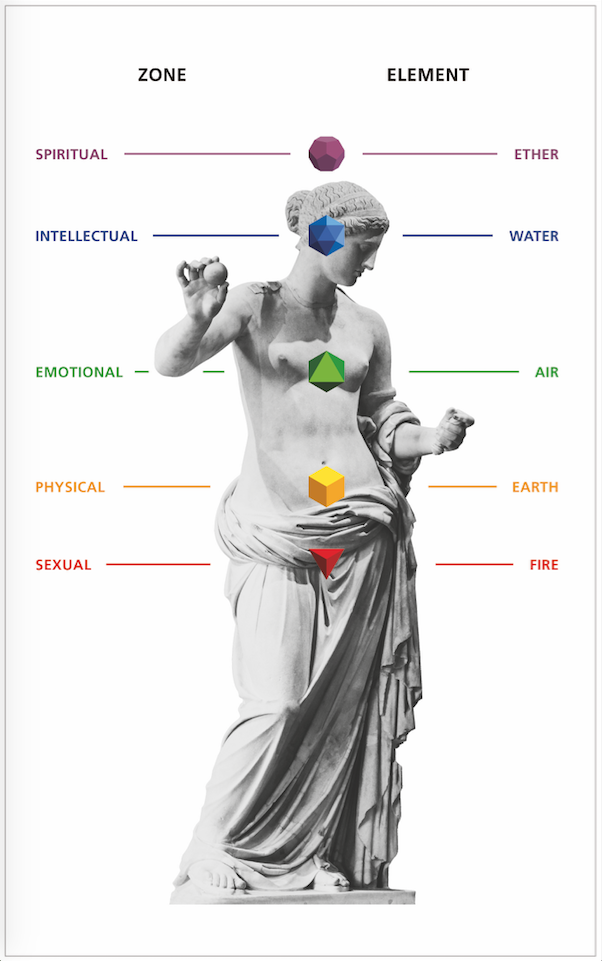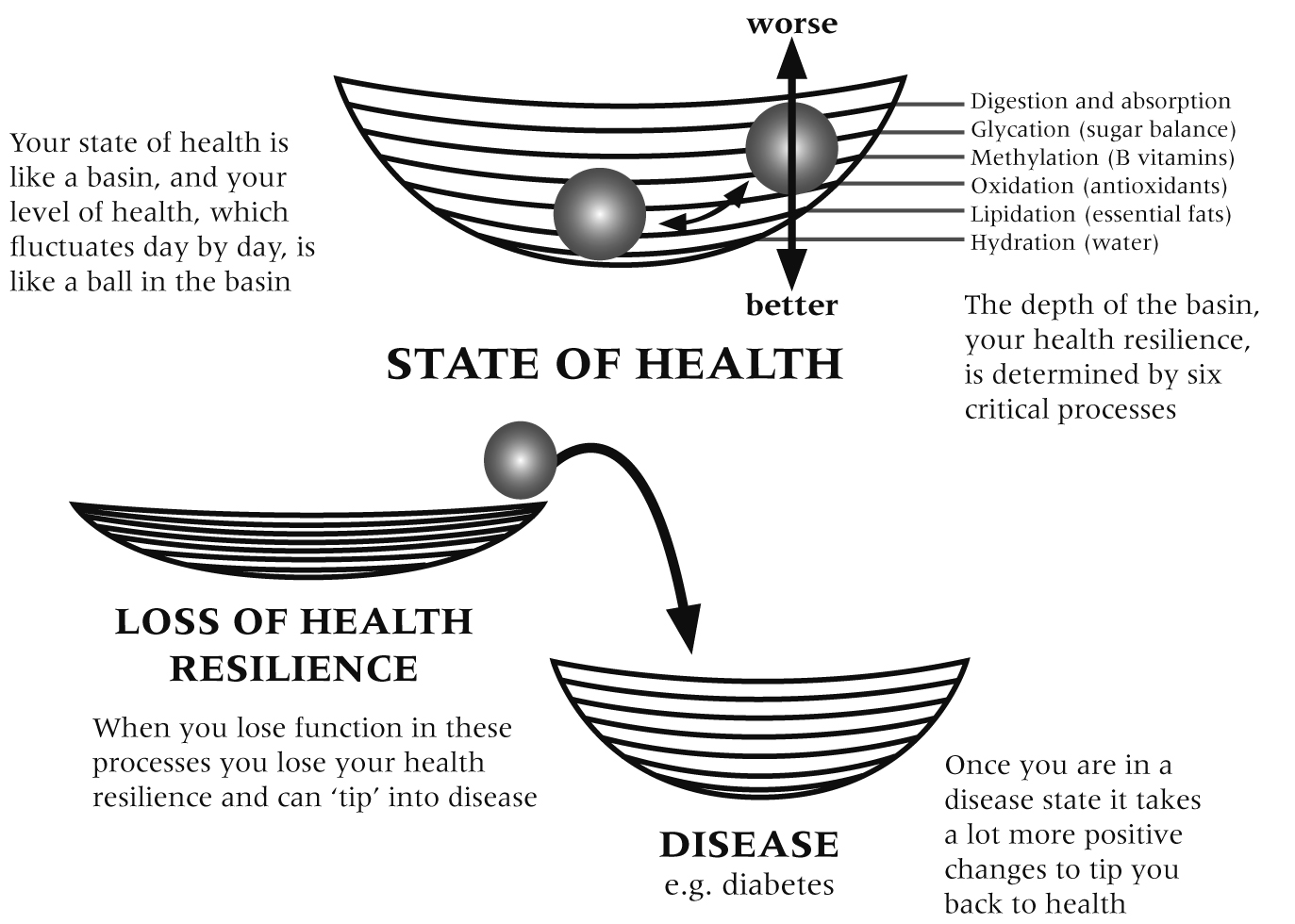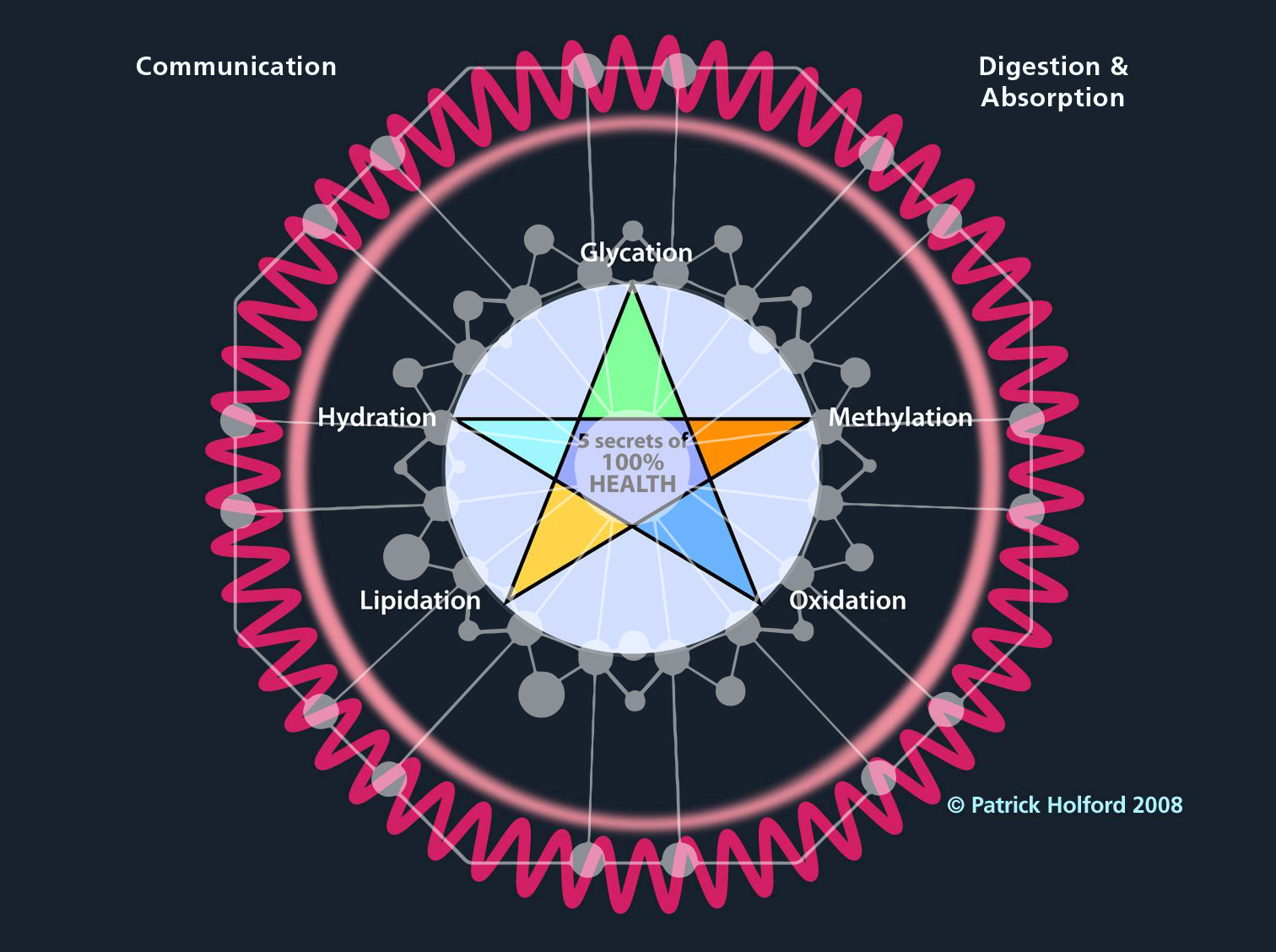These aspects of our essential design are reflected in our core anatomy divided into five cavities. The pelvic cavity containing our sexual and reproductive organs, the abdominal cavity containing the organs of digestion which liberate the sun’s energy from food, the thoracic cavity, containing our organs of circulation – the lungs, heart and kidneys; the cranial cavity of our brain relating to mind, and finally the vertebral or dorsal cavity of the spinal chord, connecting everything together. We are integral, in that each of these ‘layers’ of our design are intertwined. I have explored all this and more in The Chemistry of Connection.

Five cavities
As a psychologist, turned nutritional therapist, I have spent the past 37 years exploring the chemical aspect, and particularly it’s interaction with thought and emotions. This article drills down into the fundamental design of our bio-chemistry to provide a rapid tool for finding out what’s drivcing your health issues and how to solve them. I will not be addressing other aspects such as physical and psychological.
The Greeks spoke of the five elements, that is earth, air, water, fire, all happening in ether(space). They ascribed the elements to aspects of our being and thus were true system-based pioneers.

The Five Zones of Connection
[Reproduced with kind permission of Malcom Stewart from Symbols of Eternity]
Thanks to the legacy of great scientists, from Mendeleyeff to Einstein we now know that energy organises into sub-atomic particles, atoms (elements), molecules and molecules exist within certain core structures. 97% of our body is made of five elements – carbon (C), hydrogen (H), oxygen (O), sulphur (S) and nitrogen (N). The origin of carbon is stardust. Joni Mitchell nearly had it right – we are stardust, we are CHOSN, and we’ve got to get ourselves back to the garden.

Macronutrients
Our basic macronutrients are proteinProteins are large molecules consisting of chains of amino acids. Proteins are essential nutrients for the human body – they are a building block of…, our essential building material; carbohydrateCarbohydrates are the primary source of energy for the body as they can be broken down into glucose (sugar) more readily than either protein or… (CHO), and fatThere are many different types of fats; polyunsaturated, monounsaturated, hydrogenated, saturated and trans fat. The body requires good fats (polyunsaturated and monounsaturated) in order to… (CH), which contain trapped solar energy as our source of fuel; air (O&CO2) required for it’s combustion; water (H20) making up two thirds of our mass. The homeo-dynamics of our chemistry is orchestrated by methylationMethylation is what occurs when the body takes one substance and turns it into another, so that it can be detoxified and excreted from the… (CH3) with vitamins, minerals, essential fats including vitamin DWhat it does: Helps maintain strong and healthy bones by retaining calcium. Deficiency Signs: Joint pain or stiffness, backache, tooth decay, muscle cramps, hair loss…., phospholipids and other essential and semi-essential micronutrients as catalysts. How these players of our chemical orchestra organise and adapt, or fail to do so, is one of the core causes of disease.
A ‘systems’ based approach to healthcare, since we are complex, adaptive and self-organising system, requires a fundamental understanding of core processes. Capra and Luisi’s The Systems View of Life: A Unifying Vision (Cambridge University Press) explores this across several sciences. One fundamental learning, called ‘resilience theory’ it that one can define the health of a system by its resilience to change, and that there are rarely more than half a dozen critical processes or factors that define the resilience of a complex adaptive system. I have come to conclude that there are seven (in the chemical domain) that define our health.
Fundamental to systems thinking is the concept of ‘resilience’, which we can think of as the amount of money we have in our health deposit account. One common finding coming out of systems-based studies of complex adaptive systems, whether applied to economies, ecologies or health (our body’s ecology), is that there are rarely more than half a dozen critical factors that keep the system healthy. Small changes in these factors can ‘tip’ a system into ill-health. (For further reading, read Resilience Thinking by Brian Walker and David Salt.) The vast majority of the health problems we suffer from are a consequence of losing our resilience in one or more of only seven core biological processes shown below.

How We Tip from Health to Disease by Losing Resilience
Another finding in systems-based science is that we need much more extreme changes to ‘tip’ ourselves back into health. For example, we all need about 50 micrograms (mcg) of the essential mineral chromiumWhat it does: Helps balance blood sugar, normalise hunger and reduce cravings, improves lifespan, helps protect cells, essential for heart function. Deficiency Signs: Excessive or… a day to keep blood sugar levels stable. However, diabetics require in the region of 500mcg a day – 10 times the usual amount– to help reverse it. [1] Simply eating a well-balanced diet may prevent it, but it won’t reverse it. The dose is critical as illustrated by two recent studies giving chromium to diabetics, one which failed to show significant effect at 200mcg [2], and another which did at a dose of 500mcg .[3]
Another example is vitamin CWhat it does: Strengthens immune system – fights infections. Makes collagen, keeping bones, skin and joints firm and strong. Antioxidant, detoxifying pollutants and protecting against…. I eat about 200 milligrams (mg) a day and supplement an additional 900mg twice a day as part of the ‘big 3’ programme in my Health Packs, giving myself a total daily intake of 2,000mg. However, if I get the first signs of a cold or flu, I take 1,000mg an hour, usually as a high strength powder, until the symptoms are gone. Only high daily doses of vitamin C – 8g or more within 24 hours – have been shown to significantly shorten duration of colds. [4]
Seven Core Biological processes
The first five core biological processes are best comprehended by considering a cell. It requires fuel to function (glycation) combusted with oxygen thus generating oxidants and CO2 (oxidation), is dependent of water (hydration) and complex fats – the membrane of cells, such as neurons, is fundamentally composed of long-chain fatty acids and phospholipids (lipidation). Many of these processes, and the ability to ‘read’ DNA instructions, is dependent on methylation, itself dependent on B2, B6, folate, B12, TMG and zincWhat it does: Component of over 200 enzymes in the body, essential for growth, important for healing, controls hormones, aids ability to cope with stress…. This is why I recommend a low GL diet, with fish and seeds for omega-3s and vitamin D, lots of vegetables and fruits rich in antioxidants, beans and whole foods rich in B vitamin. In addition I also supplement all these in my daily vitamin/mineral/antioxidant and essential fat supplement pack.
Much emphasis is placed on genetics but as Professor Tim Spector’s research into the pattern of diseases of monozygotic twins has shown, inheritability (which is more than genes) accounts for in the order of 20% of disease risk. [5] He found that heritability only accounted for more than 50% of risk for autism, osteoarthritis and type 2 diabetes.
There is a sixth fundamental process and that is eating, digesting and absorbing the right food and drink in the first place. The explosion of interest in the microbiome is bringing the core role of the digestive system into focus. My latest book, Improve Your Digestion, explains how to tune up your digestion and improve your absorption.

Seven Fundamental Processes
There is a seventh fundamental process which I call ‘communication’ and relates to a communication network as an essential part of our adaptability. The chemicals of communication include neurotransmitters, hormones, cytokines and immunoglobulins such as IgE and IgG, the markers for food allergies and intolerances. When you have a food intoleranceFood intolerance is not the same as a food allergy. Food intolerances tend to cause digestive symptoms such as bloating, cramps and diarrhoea, but are… test it is measuring your IgG antibodies to specific foods. If you have an allergy skin prick test this is based on IgE reactions.
There are five main kinds of cytokines: interleukins (eg IL-1,2,6); tumour necrosis factor (TNF); interferon makes cells put up their guard against an infection. Injecting interferon is now a treatment to boost immunity; chemokines induce chemotaxis which makes things move towards the battle ground, a process that is vital in healing wounds, or disabling a pathogenic bacteria such as in food poisoning. (inc VEGF); lymphokines, produced by lymphocytes, also tell other cells to move to an infected area, and encourage other immune ‘B’ cells to produce antibodies.
Cancer represents a communication breakdown between cells. Schizophrenia and auto-immune diseases also reflect a communication breakdown, as do conditions where a person is in a chronic state of inflammation.
Each of these seven core processes can be assessed on a scale of function. This is what the 100% Health Check measures, giving you a score out of 100% for each of these core processes. If you’ve had any relevant blood tests you can enter your results to improve the accuracy.
For example, homocysteineHomocysteine is an amino acid found in the blood. Elevated levels of homocysteine have been associated with narrowing and hardening of the arteries, an increased… level is a very good indicator of methylation ‘resilience’, as glycosylated haemoglobinHaemoglobin is the protein that is found in red blood cells. It contains iron and is responsible for carrying oxygen from the lungs to the… (HbA1C) is for glycation. By assessing your resilience in each of these seven core processes it almost invariably becomes clear both what is driving your health issue, and how to correct it (on a chemical level as other aspects such as psychological and physical are also important).
Diagnosing and Treating Across the Seven Core Processes
Brigitte, age 65, is a case in point. She collapsed and was diagnosed with acute myeloid Leukemia. She almost died. While she was saved, in this instance, with chemotherapy, the critical question as to why she had developed this was brushed off by her consultants.
She more or less followed a low glycemic load (GL) diet, struggling with her weight, so that ruled out glycation as the major driver. The key here is to keep insulinInsulin is a hormone made by the pancreas. It is responsible for making the body’s cells absorb glucose (sugar) from the blood…. levels down, especially insulin-like growth factor (IGF-1) which promotes cancer cell growth. This is the likely mechanism by which dairy products promote cancer risk, the evidence for which is strongest in relation to prostate cancer. [6] Since dairy products promotes IGF-1 levels I put her on a dairy-free diet. The GL of a diet best predicts the insulinemic response [7] so I encouraged her to eat a low GL diet as well.
She grew her on vegetables and, on testing, her red cell glutathione level was adequate at 2mmol/l so that suggestion that faulty oxidation also wasn’t the primary driver.
Her homocysteine, however, was 30mmol/l way above the ideal level of below 10 for someone in their 60’s. Faulty methylation is very strongly linked to leukemia, often driven, as was true in her case, by decreasing ability to absorb vitamin B12 and the need for high doses in the region of 500mcg a day. One year on her homocysteine level is below 10.
Given that cancer is a communication breakdown the next avenue to explore was adrenal status, hormonal growth factors and systemic immunity. The body has two defence mechanisms. The ‘external’ fight flight stress response is how we gear up to fight for our survival. Brigitte was addicted to nicotine. Although she has quit smoking she was never far from her e-cigarette. The effect of nicotine is to channel energy into adrenal dominant mode, and thus suppressing immunity. Also, post-menopausally, the drop in progesteroneProgesterone is one of the main female sex hormones…. leads to adrenal dominance which lies behind many menopausal symptoms. The ‘internal’ stress response is immune system activation in response to a perceived internal threat, which is what happens in auto-immune diseases and states of chronic inflammation.
Her chemosensivity test (RGCC) showed that the most effective natural cytotoxic agent for her was vitamin C. She immediately started high dose (40g) oral vitamin C up to bowel tolerance. Intravenous vitamin C would also have been a valid option and often makes chemotherapy less toxic and more effective is given simultaneously. Vitamin D was also indicated so she took 80mcg short term to bring her blood level above 75nmol/l which is the level that confers the most immune resilience. [8]
The test also showed that the most effect growth inhibitors for her would be the phytoestrogen genistein and indole-3-carbonol, rich in cruciferous vegetables such as broccoli, which helps eliminate excess oestrogenOestrogen is one of the main female sex hormones….. The combination of genistein and I3C is known to inhibit oestrogen receptor activity in human breast cancer cells. [9] I almost always give these routinely, as part of a female balance formula, to my post-menopausal clients and those struggling with hormonal issues. Three years on she is in robust health with no need for medication.
This brief case illustrates that, if you consider health issues across these seven essential processes – glycation, oxidation, methylation, lipidation, hydration, digestion and communication – you will rapidly start to see the wood from the trees.
Take the FREE Holford Health Check
If you want to know how you would score with these processes, take my FREE 100% Health Check which assesses each out of 100% – thus identifying your weakest link and tracking your return to ‘100% healthy’ resilience.
You’ll be given a 44 page report with an Overview, System Score, Process Score, Diet Score, Nutrient Status, Weight Statistics, Lifestyle Score and of course an Action Plan.
A benefit is that this way of looking, is that it immediately focuses attention on the best treatment options, designed to tune up the weakest processes. As Marcel Proust said ‘The real act of discovery is not to find new lands, but to see with new eyes.’
References
- See www.patrickholford.com/advice/chromium-the-evidence
- M Guimaraes et al, J Trace Elem Med Biol, 2016
- AN Paiva et al, Trace Elem Med Biol, 2015
- H Hemila et al, Cochrane Library, 2007
- T Spector, Genome Med, 2014
- S Harrison et al, Cancer Causes Control, 2017
- J Bao et al, Am J Clin, 2011
- H Bischoff-Ferrari, Adv Exp Med Biol, 2014; also P Pludowski et al, J Steroid Biochem, 2017
- S Fan et al, BR J Cancer, 2006

Comments
Join the Conversation on our Facebook Page